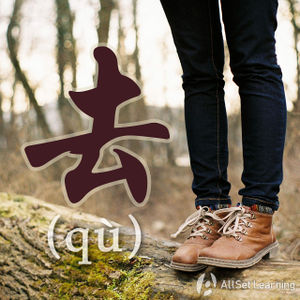Difference between revisions of "Using the verb "qu""
ViktorMugli (talk | contribs) |
|||
| Line 1: | Line 1: | ||
{{Grammar Box}} | {{Grammar Box}} | ||
| + | |||
| + | == StructureA == | ||
| + | |||
The verb 去 means "to go", and is an easy way to talk about going to places. | The verb 去 means "to go", and is an easy way to talk about going to places. | ||
| − | |||
| − | |||
<div class="jiegou"> | <div class="jiegou"> | ||
| Line 10: | Line 11: | ||
</div> | </div> | ||
| − | + | some examples: | |
<div class="liju"> | <div class="liju"> | ||
| Line 20: | Line 21: | ||
</div> | </div> | ||
| − | + | You can also use 去 to ask questions: | |
<div class="liju"> | <div class="liju"> | ||
| − | * | + | * 你 <em>去</em> <strong>那儿</strong>? |
| − | + | ||
| − | + | </div> | |
| + | |||
| + | == StructureB == | ||
| + | |||
| + | The 'place' can also be some sort of action. The sentence then means "Going to do (something)". | ||
| + | |||
| + | <div class="jiegou"> | ||
| + | |||
| + | Subject + 去 + Verb | ||
</div> | </div> | ||
| − | + | some examples: | |
<div class="liju"> | <div class="liju"> | ||
| − | * | + | * 我 <em>去</em> 工作。 |
| + | * 他 <em>去</em> 上课。 | ||
| + | * 他们 <em>去</em> 买 衣服。 | ||
</div> | </div> | ||
==See also== | ==See also== | ||
| + | |||
| + | *[[Expressing movement]] | ||
== Sources and further reading == | == Sources and further reading == | ||
Revision as of 09:45, 10 August 2012
-
Level
-
Similar to
-
Used for
-
Keywords
StructureA
The verb 去 means "to go", and is an easy way to talk about going to places.
Subject + 去 + Place
some examples:
- 我 去 学校。
- 他 去 图书馆。
- 她 去 邮局。
You can also use 去 to ask questions:
- 你 去 那儿?
StructureB
The 'place' can also be some sort of action. The sentence then means "Going to do (something)".
Subject + 去 + Verb
some examples:
- 我 去 工作。
- 他 去 上课。
- 他们 去 买 衣服。
See also
Sources and further reading
Books
- Integrated Chinese: Level 1, Part 1 (3rd ed) (pp. 106) [http://www.amazon.com/gp/product/0887276385/ref=as_li_ss_tl?
Expressing movement



